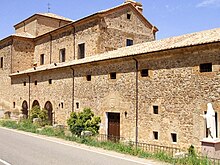You can help expand this article with text translated from the corresponding article in French. (May 2019) Click for important translation instructions.
|

A convent is an enclosed community of monks, nuns, friars or religious sisters. Alternatively, convent means the building used by the community.
The term is particularly used in the Catholic Church, Lutheran churches, and the Anglican Communion.
Etymology and usage
The term convent derives via Old French from Latin conventus, perfect participle of the verb convenio, meaning "to convene, to come together". It was first used in this sense when the eremitical life began to be combined with the cenobitical. The original reference was to the gathering of mendicants who spent much of their time travelling. Technically, a monastery is a secluded community of monastics, whereas a friary or convent is a community of mendicants (which, by contrast, might be located in a city), and a canonry is a community of canons regular. The terms abbey and priory can be applied to both monasteries and canonries; an abbey is headed by an abbot, and a priory is a lesser dependent house headed by a prior. In the Middle Ages, convents often provided to women a way to excel, as they were considered inferior to men. In convents, women were educated and were able to write books and publish works on gardening or musicology. or on religion and philosophy. The abbess of a convent was often also involved in decisions of secular life and interacted with politicians and businessmen. Unlike an abbey, a convent is not placed under the responsibility of an abbot or an abbess, but of a superior or prior.
In modern English usage, since about the 19th century, the term convent almost invariably refers to a community of women, while monastery and friary are used for communities of men. In historical usage they are often interchangeable, with convent especially likely to be used for a friary. When applied to religious houses in Eastern Orthodoxy and Buddhism, English refers to all houses of male religious as monasteries and of female religious as convents.
History
The mendicant orders appeared at the beginning of the 13th century with the growth of cities; they include in particular the Dominicans, the Franciscans, the Carmelites, and the Augustinians. While the Benedictine monks and their various variants devoted themselves to their agricultural properties, the mendicant friars settled from the start in the cities, or in the suburbs thereof, preferably in the poorer and more densely populated districts. They therefore had to adapt their buildings to these new constraints.
See also
References
- Evangelisti, Silvia (2008). Nuns: A History of Convent Life, 1450–1700. Oxford University Press. pp. 38–39. ISBN 9780199532056.
Finally, irrespective of religious beliefs, convents remained a possible model for women—Catholic as well as Protestant—to pursue. In Protestant Germany, forms of female religious associative life did not die out, but instead survived in the shape of Protestant convents. These could be governed by a Lutheran abbess, and inhabited by Lutheran nuns in religious habits who claimed membership of a monastic order, paradoxical though this may seem.
- ^ Hunt, Julie (21 July 2020). "Nuns: powerful women of the Middle Ages". Swissinfo. Retrieved 2022-09-26.
- See Etym on line
External links
- Herbermann, Charles, ed. (1913). "Convent" . Catholic Encyclopedia. New York: Robert Appleton Company.
- Carmelite Monastery of the Sacred Hearts — an example of a modern-day convent
- Chisholm, Hugh, ed. (1911). "Convent" . Encyclopædia Britannica (11th ed.). Cambridge University Press.
| Consecrated life in the Catholic Church | ||
|---|---|---|
| Types |  | |
| Vows | ||
| Monastery (List) | ||
| Prayer | ||
| Habit | ||
| Members | ||
| Other | ||